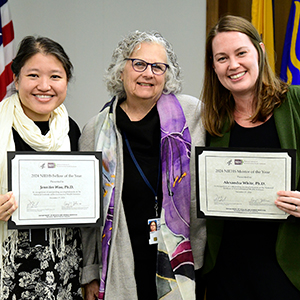Anita Hopper, Ph.D., shared insights into how transfer ribonucleic acid (tRNA) responds to environmental stressors during the NIEHS Distinguished Lecture held March 14. The Ohio State University professor described how different tRNAs, which play a key role in protein synthesis, move around within cells and alter gene expression.

Robin Stanley, Ph.D., who leads the Nucleolar Integrity Group and holds a secondary appointment in the NIEHS Genome Integrity and Structural Biology Laboratory, hosted the lecture.
“Over the years, work from the Hopper lab has beautifully established that tRNA trafficking inside the cell is bi-directional,” Stanley said. “Using yeast as a model system, her lab has identified the major cellular players involved and established that tRNA trafficking dynamically responds to environmental stress, leading to the regulation of gene expression.”
According to Hopper, who is a member of the National Academy of Sciences, the American Association for the Advancement of Science, and member and past president of the RNA Society, researchers are still working to untangle the production, alternative functions and cell biology of tRNAs.
“I am enthralled with the complexity and regulation of this molecule,” Hopper said. “It serves as a conduit from genome to the proteome. Any misstep in the production of tRNAs can cause a variety of diseases, both mitochondrial and neurological.”
Do the cellular shuffle
During the lecture, Hopper discussed the movement of tRNAs from a cell’s nucleus to cytoplasm, which is an essential step in every living organism, including humans. Although scientists knew of one cellular pathway that delivered tRNAs after transcription in the nucleus to the cytoplasm, it was not essential in all living organisms. The Hopper lab recently discovered two parallel pathways involving Mex67-Mtr2 and Crm1, respectively, through which tRNA is shuffled from nucleus to cytoplasm.

A subset of tRNAs contain introns — segments of nucleic acid that interrupt the mature gene sequence. These introns need to be removed before a tRNA can function in protein synthesis. Failure to remove introns is one way that tRNA can become nonfunctional.
“Cells make an enormous number of intron-containing tRNAs,” Hopper explained. “About 600,000 molecules of free introns are generated every cell cycle and you almost never see them. They are very efficiently turned over.”
Second chances
Still-attached introns are just one way that tRNA can become problematic. To synthesize proteins accurately, tRNAs must themselves form completely correctly within the cell. If not functioning properly, they misfold, decrease stability, and cause errors in decoding the genome.
Malformed tRNA occasionally move from the nucleus to cytoplasm prematurely. One of Hopper’s mentees, Emily Kramer, found that retrograde movement back to the nucleus serves an important role in tRNA quality control.
“One of my favorite ideas is that when they return to the nucleus, maybe they are given a second chance,” Hopper said. “They get their end processed and end up whole.”
Impact beyond the lab
In addition to her research contributions, Hopper is known for her commitment to mentoring future scientists.
“Throughout her career, Dr. Hopper has been an outstanding mentor and role model to budding RNA scientists both in her own lab and the larger RNA community,” Stanley said. “She has been an incredibly active member of the RNA Society, who honored her with the Society’s Lifetime Service Award in 2009 and the Lifetime Achievement Award in 2015.”
Citation: Kramer EB, Hopper AK. 2013. Retrograde transfer RNA nuclear import provides a new level of tRNA quality control in Saccharomyces cerevisiae. Proc Natl Acad Sci U S A. 110(52):21042-7.
(Kelley Christensen is a contract writer and editor for the NIEHS Office of Communications and Public Liaison.)









